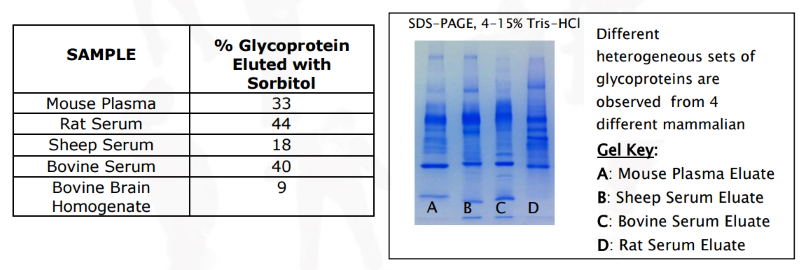|
Discovery Of Glycoprotein Biomarkers Using NuGel™ Glycoprotein Enrichment Phenyl Boronic Acid (PBA) Kit. MONMOUTH JUNCTION, NJ.– Providing unrivalled specificity, NuGel™ Glycoprotein Enrichment PBA Kit contains phenyl boronic acid which covalently reacts with 1,2-cis-diol group–containing molecules. This unique chemistry eliminates the requirement for forming complex saccharide recognition motifs for interaction. The PBA ligand binds to the 1,2-cis-diol groups of biomolecules and enriches for heterogeneous sets of glycoproteins containing both N-linked and O-linked oligosaccharides. The specialized heterogenous nature of NuGel™ Glycoprotein Enrichment PBA Kit’s organo-boronic acid groups makes it applicable to all kinds of glycopeptides regardless of the sizes, structures, and hydrophilicities. The boronic acids facilitate the capturing of heterogeneous groups of O-linked oligosaccharides. NuGel™ Glycoprotein Enrichment PBA Kit provides good reproducibility, simple protocol, and high-throughput capability. For detailed structural characterization of low-abundance glycoproteins, NuGel™ Glycoprotein Enrichment PBA Kit enriches glycoproteins from blood, serum, plasma, tissue or cell culture media. Glycoprotein isolation and enrichment might lead to biomarkers eg: biomarkers may be glycoproteins present in only minute quantities in tissue extracts and physiological fluids.

About Biotech Support Group LLC Biotech Support Group LLC is a leading developer of proteomic and genomic sample preparation and enrichment products. Its principal products include: AlbuVoid™ for albumin depletion, Cleanascite™ for lipid adsorption and clarification, HemogloBind™ & HemoVoid™ for hemoglobin removal, NuGel™ for functional & chemical proteomics, and ProCipitate™ & ProPrep™ for nucleic acid isolation. For more information, go to www.biotechsupportgroup.com. CONTACTS:
Dr. Swapan Roy & Matthew Kuruc
|

- About
- Products
- Hemoglobin Removal Kits
- Lipid Removal & Clarification
- Urine Protein & Low Abundance Enrichment
- Class Specific Enrichment
- Sample Prep Mass Spectrometry
- Functional & Chemical Proteomics
- Genomic Sample Prep
- Accessories
- Technical Resources
- References
- Publications & Reports
- FAQs
- Case Studies
- Cleanascite™ Unlocks Insights into Lipid-Driven Tumor Immunosuppression
- NRicher™ Bead Platform Provides Unique Sub-Proteome Biases And Fit For Purpose Opportunities for Targeted LC-MS Quantification
- BSG Products To Assist in Analyzing Macrophage Polarization
- Ectodomain Shedding and Enrichment of the Soluble Membrane Proteome
- Investigate out of the Venn Diagram box
- Methods to selectively deplete or purify Hemoglobin from Dried Blood Spots (DBS)
- The Utility of HemoVoid™ is Demonstrated in 3 Proteomic Investigations Identifying Potential Disease Specific Biomarkers
- The 4 common features of our sample prep products, known as the BSG Advantage, are highlighted in a selection of journal references.
- AlbuVoid™ Workflows Advance Cell Secretome Proteomics
- Lipid Removal for Phenotypic Cell Response in Cancer Research
- The Influence of Sample Prep Bias on LC-MS Targeted Peptide Quantification in Serum Proteomics
- Re-imagining proteomics for developing precision medicine biomarkers of the innate immune response in SARS-CoV-2
- Patent Application Describes New Proteomic Methods to Monitor Protease Inhibitor Function During Covid-19 Infections
- Efficient Hemoglobin Removal Advances Red Cell Proteomics Offering Many New Insights Into Inflammation and Infectious Disease
- The Potential for New Blood Biomarkers in the Management of COVID-19 Disease
- Establishing the Utility of HemoVoid™ and HemogloBind™ as Enrichment Tools for Proteomic Analysis of Red Cells and Whole Blood in Parkinson’s Disease
- Species Diversity Supported By BSG Products
- Poster Report Describes Loss of Functional Serpin Activity In Cancer Patient Blood
- AlbuVoid™️ PLUS & AlbuSorb™️ PLUS Evaluating Different Windows of Observation Solves The Many Challenges of Serum Proteomics
- Tackling the Challenges of Serum Proteomics
- Lipid Removal Sample Prep for Cell Response Applications
- Sample Prep for Proteomic Analysis of Saliva
- Biotech Support Group Featured in Book, "Functional Proteomics – Methods and Protocols"
- Sample Prep Liquid Biopsy Products Suitable for Proteomic Profiling of a Variety of Body Fluid Sample Types
- Albumin and High Abundance Depletion
- Using HemogloBind™ as a Hemoglobin Binding Reagent
- Diverse technologies available for researchers to selectively bind or enrich exosomes and extracellular vesicles.
- Stroma Liquid Biopsy™ Biomarkers Profile Pan-Cancer Dysregulation of the Serum Proteome
- Diverse Depletion and Enrichment Technologies Enhance Simplicity and Efficiency of Obtaining Quality Proteomic Information
- Use On-Bead Digestion to Improve Time Required for Serum Digestion
- Using AlbuVoid™ as a Serum Protein Enrichment Kit in Functional Proteomics
- Using Cleanascite™ as a Lipid Absorption and Clarification Reagent
- Using HemoVoid to Remove Hemoglobin Before Analysis
- Blog
- Contact
- Liquid Biopsy